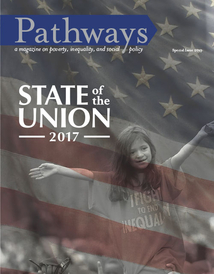State of the Union 2017

The annual Poverty and Inequality Report provides a unified analysis that brings together evidence across such issues as poverty, employment, income inequality, health inequality, economic mobility, and educational access to allow for a comprehensive assessment of where the country stands. In this year’s issue, the country’s leading experts examine racial and ethnic inequalities in the United States.
Table of Contents (Special Issue 2017)
Are our country’s policies for reducing racial and ethnic inequalities getting the job done? The simple answer: No.
Even after the recovery, 1 in 9 African Americans and 1 in 6 Hispanics fear a job loss within one year. Why?
We remain two Americas: a high-poverty America for blacks, Hispanics, and Native Americans, and a (relatively) low-poverty America for whites and Asians.
The safety net, which is supposed to serve an equalizing function, sometimes works to exacerbate racial and ethnic inequalities within the low-income population.
Whereas 1 in 6 black and Hispanic households dedicate at least half of their income to housing costs, only 1 in 12 white households do. How did that happen?
Between 1990 and 2015, average academic performance improved for students of all racial and ethnic groups, but grew fastest among black and Hispanic students. The result: White-black and white-Hispanic achievement gaps declined by 15 to 25 percent.
Did you think that all that talk about criminal justice reform has brought about a sea change in racial inequalities in incarceration? Think again.
Large and persistent racial gaps in health are not the product of our genes but the consequences of our policies and history.
Between 1970 and 2010, the earnings gap between whites and other groups has narrowed, but most of that decline was secured in the immediate aftermath of the Civil Rights Movement.
African-Americans have less than 8 cents and Hispanics less than 10 cents of wealth for every dollar amassed by whites.
The persistence of poverty has long been stronger for blacks than whites. However, beginning with generations that came of age in the mid-1960s, the white-black gap in the chance of escaping poverty has closed significantly.
